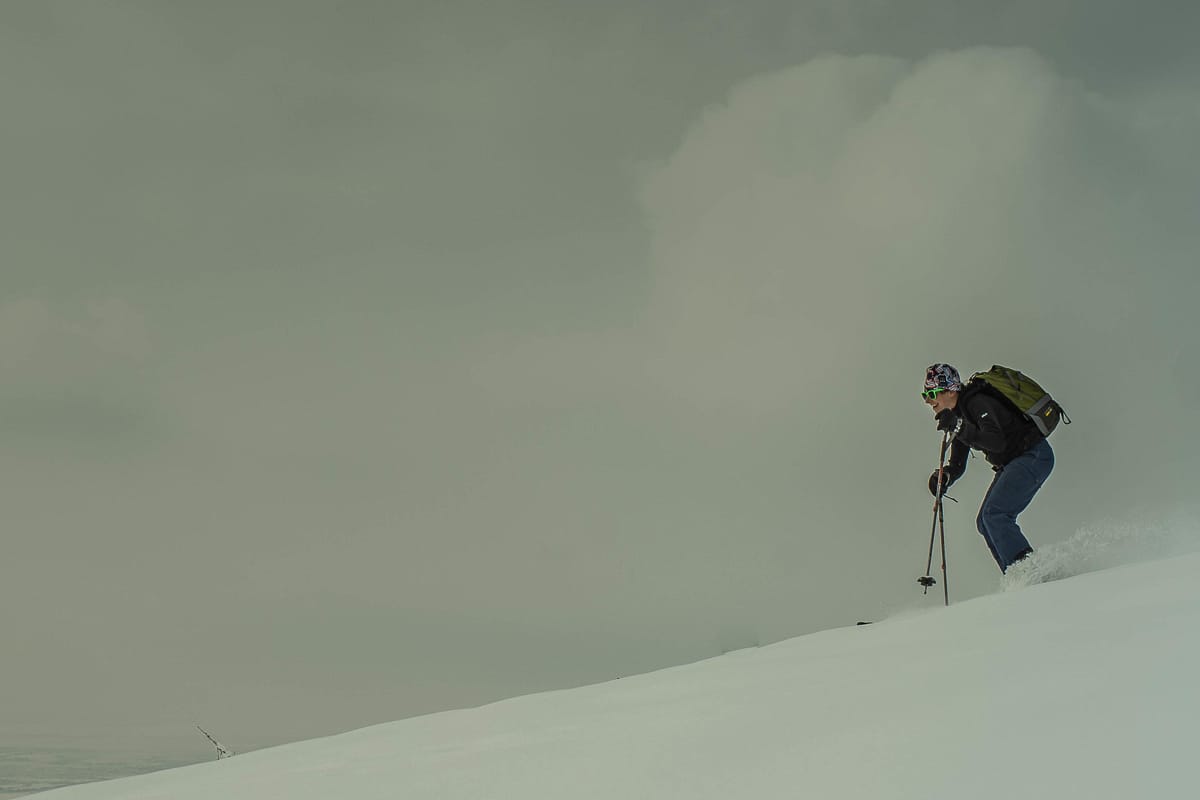
We are still moving, under our own power and according to gravity, but in a fundamentally unhuman way. Photo: Pete Vordenberg
Thoughts on skiing and its place in the cosmos—it’s a big wide place out there.
“Skiing was not the way it is now, the spiral fracture had not become common then, and no one could afford a broken leg. There were no ski patrols. Anything you ran down from, you had to climb up to first, and you could run down only as often as you could climb up. That made you have legs that were fit to run down with.”
Ernest Hemingway, A Moveable Feast
Skiing is a funny sport—we’ve gone from using skis as a means of transport to using them for leisure and self-improvement. There was a time when all skiing was human powered. Unlike the bicycle, which still has its load-carrying, quotidian use-case intact, the ski is now almost entirely in the realm of sport and exploration.
The ski is also closely associated with luxury and perhaps the futility of winter sports in a warming world. The ski is not approachable. The ski is not inclusive. The ski is long and awkward. The ski needs to slide on snow. The bicycle, on the other hand, can take your kids to school, take you to work, or deliver food. You can buy bicycles for $20,000, but the idea of the bicycle does not suffer from the perception of elitism like skiing does. The cyclist can be separated from the bike in a way that the skier cannot be separated from the ski. People ride bikes as a means of transport all over the developing world; those people do not ski.
All of this is strange because skis predate the bicycle. You could almost argue that sliding on snow predates the wheel. In 2014, a ski with leather bindings was found in Norway and was estimated to be from the 8th century. It was 145 mm underfoot, in case you were wondering, for the bottomless powder of Viking Scandinavia.
The ski was a means of transport in cold places for a long time, but late in the Industrial Revolution, skiing as transportation transitioned to skiing as sport. Here’s Hemingway again, writing about the proliferation of the ski lift:
“Nobody climbs on skis now and almost everybody breaks their legs but maybe it is easier in the end to break your legs than to break your heart although they say that everything breaks now and that sometimes, afterwards, many are stronger at the broken places.”2
Hemingway, like the Romantic poets a century earlier, lamented our alienation from nature and the steady creep of comfort and complacency. Wordsworth, Coleridge, and Shelley wrote about sociocultural change and environmental degradation. In Hemingway’s writing, nostalgia is evident: the clash of idealism and reality and nature as a backdrop. While his style was sparse and often pitiless, like Shelley he saw nature as something we beat our frailties against. Nature was the uninterested other, as seen by Shelley in his poetry written in Chamonix—the severity of the glaciers and peaks of the Mont Blanc massif lay beyond the easy comforts of religious certainty. Nature existed outside of humankind, indifferent and removed from humanity.
On which I gaze, even these primeval mountains
Teach the adverting mind. The glaciers creep
Like snakes that watch their prey, from their far fountains,
Slow rolling on; there, many a precipice
Frost and the Sun in scorn of mortal power
Have pil’d: dome, pyramid, and pinnacle,
A city of death, distinct with many a tower
And wall impregnable of beaming ice.3
One of the defining characteristics of skiing as a leisure and luxury is that it’s possible to break legs without it being a life-threatening medical issue. The Industrial Revolution gave us exosomatic energy—the prime movers like trains and cars and aircraft. The resulting medical revolution gave us antibiotics and X-rays. The financialization of everything gave us travel insurance and holidays on credit. We have strung cable cars and ski lifts over the Alps like Christmas lights. Prime movers have mediated distance and effort, making human and animal power redundant. The mediation of distance occludes a sensory system designed to perceive distance and time in a self-locomoting environment. We can be in any urban center on Earth in a matter of days. The flight from Sydney to Geneva takes 23 hours, a frankly grim period to be shoehorned into an economy seat. Yet the same journey in the time of Shelley and Byron was measured in months, not hours.

“I think the world of human-powered skiing has arrived late to the question of style.” An early Hominin skull— Sahelanthropus tchadensis. Photo: Pete Vordenberg
We are profoundly alienated not only from our environment but also from our ancestors of the 19th century. They are not only dead, they may as well have been dead for thousands of years. The exponential increase in available exosomatic energy would be as alien to Shelley as interstellar travel would be to us today. And yet, for our time in the mountains moving under our own steam, we are no longer alienated from our environment and our history.
“During our last year in the mountains new people came deep into our lives and nothing was ever the same again. The winter of the avalanches was like a happy and innocent winter in childhood compared to the next winter, a nightmare winter disguised as the greatest fun of all, and the murderous summer that was to follow. It was that year that the rich showed up.”4
Alpinism does not suffer from skiing’s identity disorder. There are no alpine climbing resorts, although the Stollenloch on the north face of the Eiger is—like the lift to the Aiguille du Midi above Chamonix—a conceit of electricity and engineering. The Stollenloch is a wooden door that connects the Eigerwand station on the Jungfraubahn to the north face. Theoretically, it is obvious which types of people belong on either side of the door. In reality, like the tourists who take the cable car up to the Aiguille du Midi, we can cross the vast liminal space that divides those with the mountaineering experience and courage to be alpinists and those comfortable at sea level on the sofa. A liminal space is not just a doorway, it might be a third of a lifetime, but our abundance of energy allows us to cross as if they were the same. A doorway is just a doorway, but the Stollenloch is a portal that divides a comfortable seat on a train from the vertical iced wastes of the Nordwand.
No, climbing and alpinism retain that sense of foreboding that skiing has never had. Perhaps because the ski, like the wheel, feels familiar, and its utility is obvious. Not so for the ice tool or the cam.
I think the world of human-powered skiing has arrived late to the question of style. The right way to do things in the high alpine and the Great Ranges was settled many decades ago by people like Messner and Kukuczka. Skiing had to make a long detour through heli-assisted freeriding or the late Warren Miller era. The early freeriders who took skiing from the groomers to the high mountains were simply extending a tradition of overcoming gravity by mechanical means. That’s not to say that there weren’t people doing phenomenal human-powered things in Europe and the Great Ranges, just that the question of style in skiing was purely a matter for the descent. Skiing was also caught in the flypaper of the X-Games behemoth, which was a way to inject something cool and dangerous into the sterile world of the ski resort. The rise of ski mountaineering is about answering this question of style. Skiing has begun to take itself more seriously. That’s not to say we aren’t having any fun, but the grand expeditions to the Great Rangers have always been serious in their objectives and their discipline. Being funded, well-trained, and battle-hardened are contingent on discipline and a certain element of pragmatism that skiing, as an atomized discipline, has always lacked.
But what is skiing? Is it the world of the resort—the groomed and tamed mountain, the après-ski and the hot-tub? Is it the FIS—the ski racers and the cowbells? Is it backcountry? If it’s about the backcountry, is it the world of the $20,000 week with CMH or the ski tour? Or is it the world of the freerider—the sidecountry and the terrain park? Obviously, it is all of these, which are activities using ski-shaped things but wildly different in character. The ski is a wonderful device in that it can enable all of these disciplines—and I haven’t even mentioned Nordic and expedition skiing. This is because the ski is a mode of transport, a piece of technology like the wheel that enables a transmutation of human travel. We are still moving, under our own power and according to gravity, but in a fundamentally unhuman way. The ski is a technology that modifies human movement. Look at how many modes of transport and sports the wheel appears in.
Climbing, while technology dependent, is still primal activity. It’s a one-foot-in-front-of-the-other thing. Using our four limbs to overcome gravity is an evolutionary imperative. Climbing can only be a few things, depending on the medium and the weather. Perhaps this is why climbing is still the high alpine pursuit that captures the greatest share of the public’s imagination. From Paccard through Whymper and Hillary and Messner, we are dealing with better gear and clothing, but the activity is largely unchanged. It has become a matter of style and speed now, but it remains that you tie yourselves together and to the mountain and try not to fall off.
The skiing that interests me, the skiing that interests the readers of this publication (I hope) is the kind of skiing that Hemingway feared lost. The human-powered turn is back, and maybe it’s up to us to rescue the reputation of the ski from the world of the chairlift and the all-season lift pass. While I’ve got nothing against the resort, it still remains the best way for anyone to learn how to ski; skiing has veered into the orbit of cruise lines and golf in the environmental vandalism stakes. Stories about disappearing ski resorts are met with unalloyed delight.
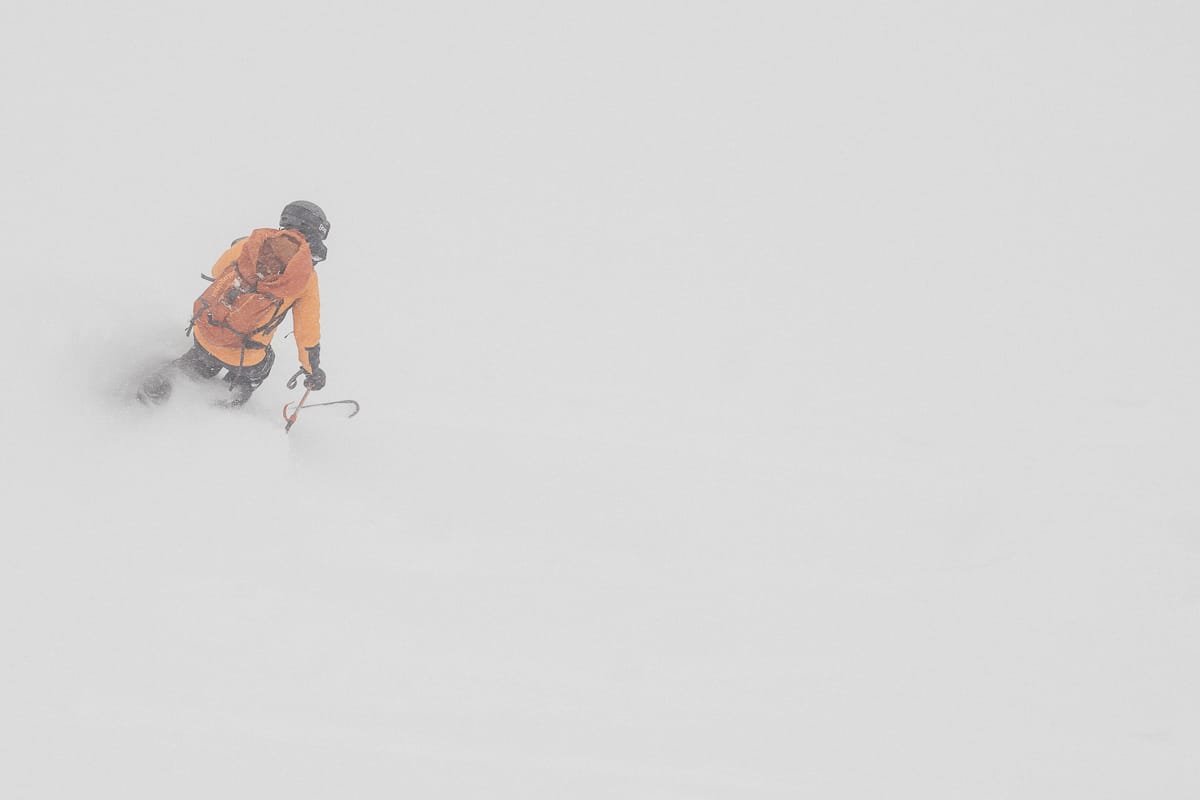
The skiing that interests me, the skiing that interests the readers of this publication (I hope) is the kind of skiing that Hemingway feared lost. Photo: Pete Vordenberg
Skiing is often held up as an example of the futility of business as usual in a warming world. Even though climbing is a much smaller market than skiing, brands often choose to market the sport as a means to sell jackets. Even when they do promote skiing, it is the freeride or backcountry aspect that gets promoted—the skier in bottomless powder or ripping down an Alaskan couloir, not carving turns at Vail or Whistler. In both cases, I’ve no doubt that the overwhelming use case is inbounds skiing. The marginal buyer is always the resort skier. Resort skiing is this huge market that many people in the outdoors industry would rather pretend doesn’t exist, which is a shame because ski racing is damn cool— and we’ve reaped the benefits of decades of technological progress in the alpine skiing world.
Ultimately, outdoor brands sell aspiration. I’d like to believe that backcountry skiing and ski mountaineering will provide those aspirational qualities. Resort skiing will continue to become more expensive and exclusive as low-latitude and low-altitude resorts become marginal propositions. While human-powered skiing might never become more than a niche part of the umbrella of doing things on ski-shaped devices, let’s hope that when you are asked what you are passionate about, you don’t have to use that annoying qualifier: “skiing, but it’s not what you think.”
“Finally there was the great glacier run, smooth and straight, forever straight if your legs could hold it, your ankles locked, you running so low, leaning into the speed, dropping forever and forever in the silent hiss of the crisp powder. It was better than any flying or anything else, and you built the ability to do it and to have it with the long climbs, carrying the heavy rucksacks. You could not buy it nor take a ticket to the top. It was the end we worked all winter for, and all the winter built to make it possible.” 5
1 With apologies to Raymond Carver
2 Ernest Hemingway, A Moveable Feast
3 Percy Bysshe Shelley, Mont Blanc: Lines Written in the Vale of Chamouni.
4 Ernest Hemingway, A Moveable Feast
5 Ernest Hemingway, A Moveable Feast

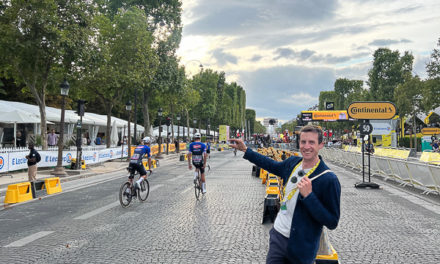
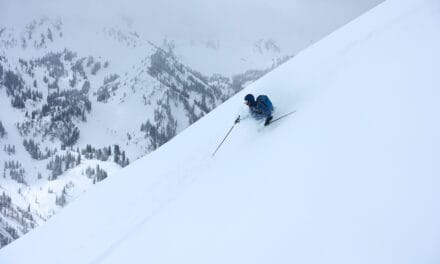
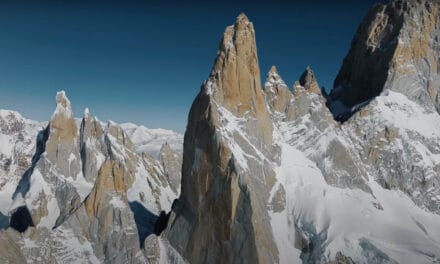
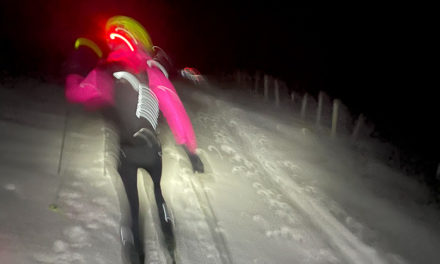
Really enjoyed reading!
Bravo!